
There have been debates around employee evaluations and some say it’s time to put an end to it. But, while big companies like Adobe have abolished the traditional rating-based performance reviews, 49% of companies still conduct annual or semi-annual employee evaluation in one form or another. Moreover, the majority of employees want to keep some form of performance ratings in place as it at least allows them to understand their standings within a company.
To make sure we’re on the same page—employee evaluation is the assessment and review of a worker’s job performance. Most companies conduct performance evaluations at specific time intervals (usually once or twice a year).
Whether you choose to give and receive employee feedback via email, paper or a one-on-one conversation, you will still need to prepare employee evaluation forms. The format and content may vary greatly, depending on your particular situation and intentions.
In this article, we’ll explore the main considerations and best practices in preparing forms for performance appraisals. If you want to, you can skip directly to the employee review templates.
Why Use Employee Evaluation Forms?
- Remind workers what their managers expect in the workplace
- Provide useful feedback about job performance
- Inform employment decisions such as promotions, pay raises, and layoffs
- Understand employee strengths and weaknesses
- Plan employee training and development programs
- Set performance goals and standards
- Understand what tools employees need to achieve their job responsibilities
- Inform recognition and reward
- Identify highly proficient workers with leadership potential
What to Include in an Employee Evaluation Form?
Employee and reviewer information
The form must have basic information about both parties involved. This includes but not limited to:
- Employee Name
- Department
- Employee ID
- Position Held
- Reviewer Name
- Reviewer Title
Review period
Employee review forms should specify the review period and the date the evaluation was held. This is to determine the progress of the employee since the last time he or she has been assessed.
An easy-to-understand rating system
It’s important to clarify your rating system so that employees understand why they are receiving a specific grade. Commonly used performance rating systems include 1 to 10 and “unsatisfactory” to “excellent”.
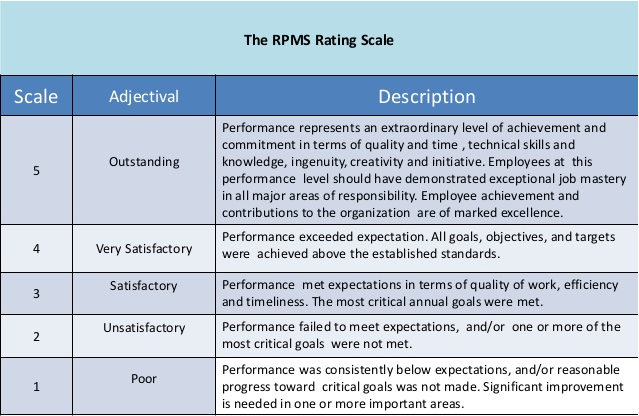
(Source)
Evaluation points
If you’re assessing specific skills or aspects of the job, you can list them in a table where they can be rated easily.
Goals
In order for performance evaluation forms to be effective, they have to inform employees of their progress and future goals. This ensures they understand the performance standards they have to meet.
Extra space for comments
Comments include additional information, allowing you to share your honest suggestions to improve performance. The comment section could also serve as a place to encourage the employee or note individual challenges and accomplishments.
Signatures
Signatures are required to ensure that both the reviewer and the employee understand the evaluation process and the contents of the evaluation form.
Best Practices For Creating Effective Employee Evaluation Forms
HBR recently reported that 65% of employees believe performance evaluations are not relevant to their jobs. The article titled “People Don’t Want to Be Compared with Others in Performance Reviews. They Want to Be Compared with Themselves”, goes on to say:
“Employees perceive the fairness of evaluation processes when they feel included and respected. They also consider it fair when their evaluations are accurate and are conducted based on ethical and moral principles.”
Certainly, evaluations can easily become subjective so management has to tread lightly. Here are a few tips on how to approach your performance review process without ambiguity.
- Gather information intentionally: Get clear about the purpose(s) of your appraisal process and ensure you are gathering the right information with your staff evaluation form.
- Stay focused: Don't try to do too much in a single performance review or a single employee review form. Run several evaluation sessions if you have to.
- Customize forms for each position: List the right core and leadership competencies for the job so that, when filled out, your employee review form will reflect performance for a specific role.
- Provide clear descriptions: Describe the job responsibilities, goals and rating system in great detail.
- Choose your rating method wisely: Some roles may be better suited to numerical ratings of competencies while others may need descriptive ratings or even multi-rater feedback.
- Set S.M.A.R.T. goals: Provide specific, relevant descriptions of the goals the worker has to achieve. Define the measurements for success and the expected completion dates.
- Address development: One of the main goals of an employee performance evaluation form is to inspire personal and professional development. Allow space for identifying and establishing training goals.
- Provide detailed feedback: Make sure employees understand what they need to do to develop and improve.
- Be objective: Use specific numbers where possible and avoid subjective or ambiguous language.
Format
There are two main formats used in employee evaluation forms.
Scorecard
This type of employee review form uses a quantitative approach. The appraiser lists job duties and personal characteristics, rating the employee's performance in various categories. This format has to be accompanied by comments to avoid ambiguity and make sure the rating is justified.
As we already mentioned, it’s very important to choose a consistent rating scale that is clearly explained. Both managers and employees should understand the meaning of the score.
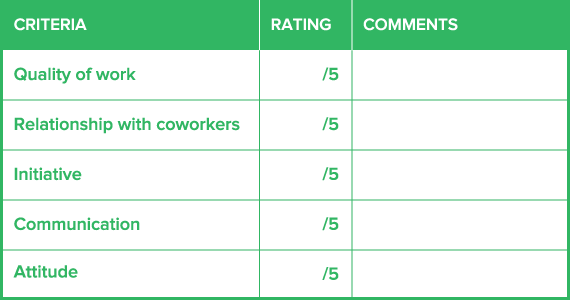
(Source)
Narrative
This employee performance evaluation format contains open-ended questions that enable managers to do a qualitative appraisal. In some cases, the employee answers some of the questions which helps spark a two-way conversation.
For example, the reviewer may answer a question like, “What are the 3 areas where employee X can improve?” and the employee may answer a question like, “What are your 3 biggest accomplishments this year?”
In practice, the employee evaluation forms that most companies use are a combination of narrative and scorecard. This enables reviewers to gather both quantitative and qualitative information and understand what drives both outstanding and unsatisfactory results.
Legal considerations
Your employee evaluation forms have to be consistent and your process has to be objective because, otherwise, your employees can raise legal concerns. Here’s what to consider when designing your forms:
- Reviews can be used as evidence in court. According to Jeffrey Horton Thomas, of Thomas Employment Law Advocates in West Hollywood, Calif, reviews become key evidence if a former employee alleges that an action taken by the employer was done for an illegal reason.
- Discrimination claims. If you use two different performance appraisal forms for two different groups of employees, you leave yourself open to discrimination claims.
- Retaliation. Be careful when you downgrade an employee’s performance, especially if he or she has complained of harassment, safety violations, wage and hour issues. If you state, for example, that such an employee “is not a team player”, you risk retaliation claims.
Employee Evaluation Templates
Below are nine of the most commonly used employee evaluation forms in PDF, Word and Excel formats.
1. General Employee Performance Evaluation Template
This is a formal review of an employee’s overall performance which can be conducted monthly, quarterly, or annually. It has questions answerable by yes or no with a general comment section at the end.
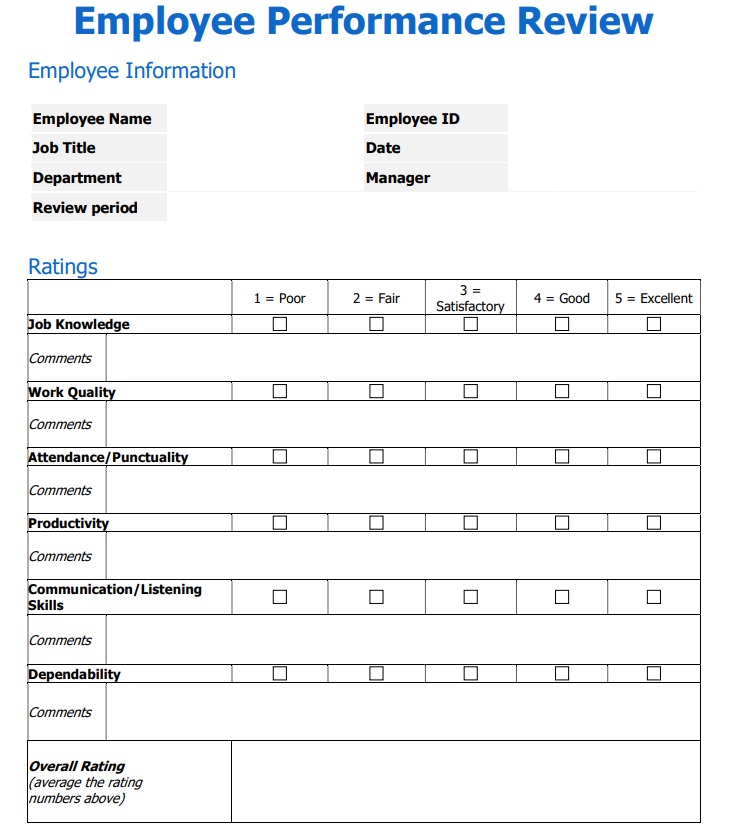
2. Essay Employee Review Template
This performance review template follows the narrative format. However, the potential downside is that the essay can be biased and contain personal grudges or incidents not directly related to performance.
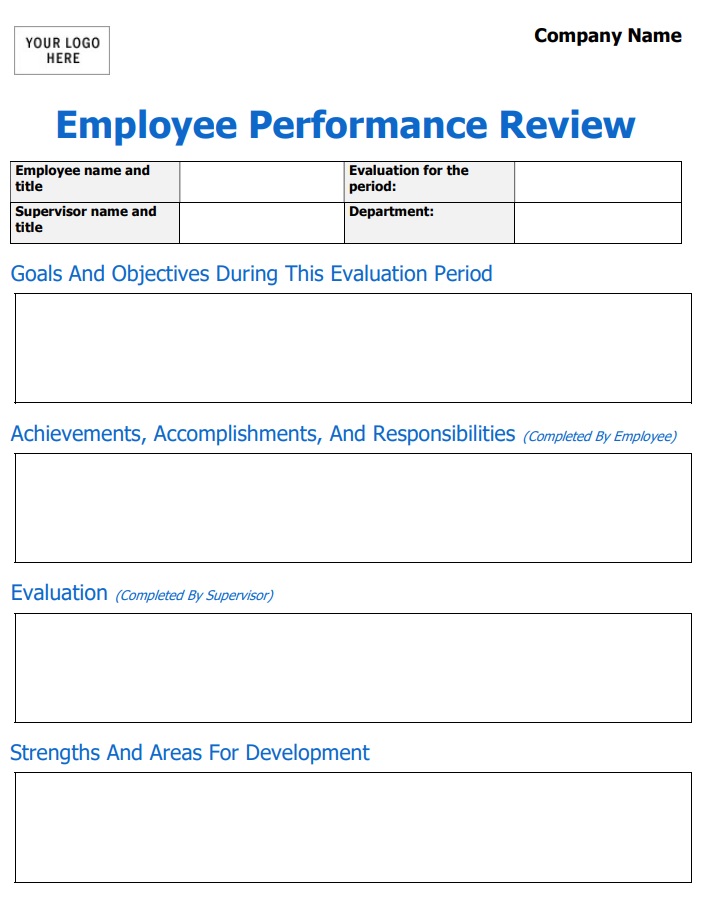
3. Numerical Scale Form
This employee performance review template uses an ordered set of numbers where respondents get to rate a statement on a scale of 1 to 10. This detailed form can easily become your annual review template because it can gather a lot of information.
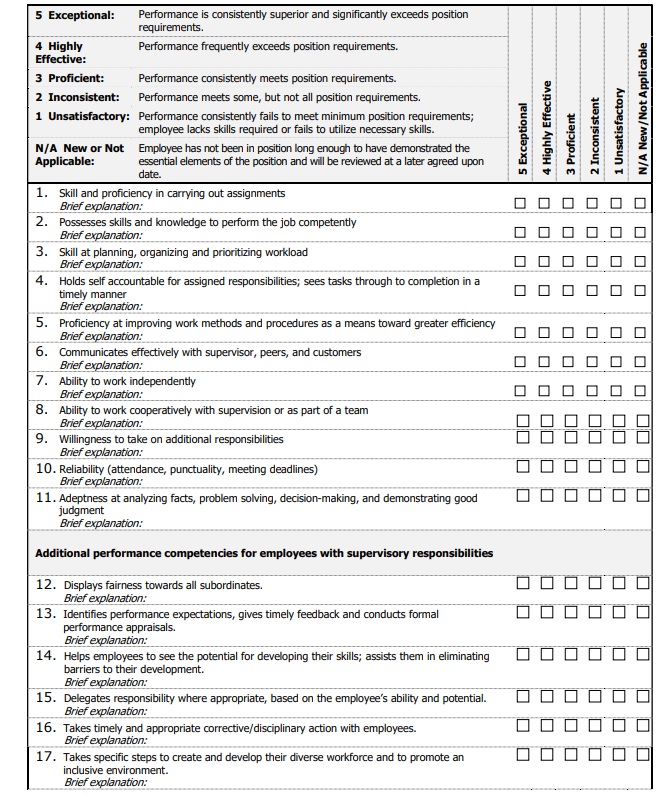
4. Peer Review Form
Peer review is commonly used in academic and professional fields but it can also be applied in other areas. The premise is simple: Co-workers and managers assess the employee’s behavior and professional qualities.
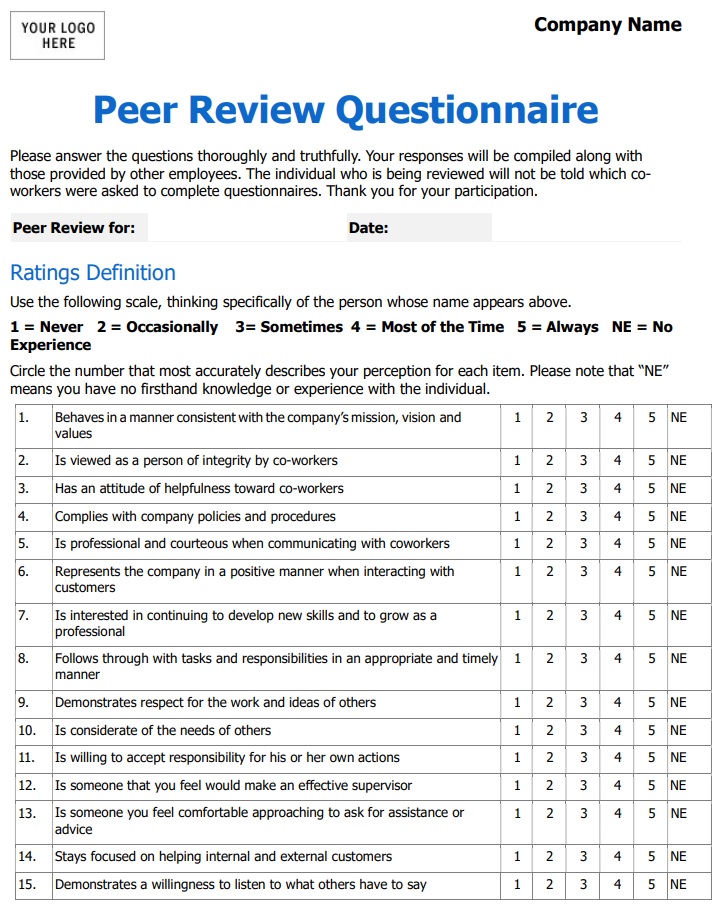
5. Group Evaluation Form
This job evaluation form can help understand team performance at scale. It uses a numerical scale to rate results, communication, adherence to deadlines and other key factors.
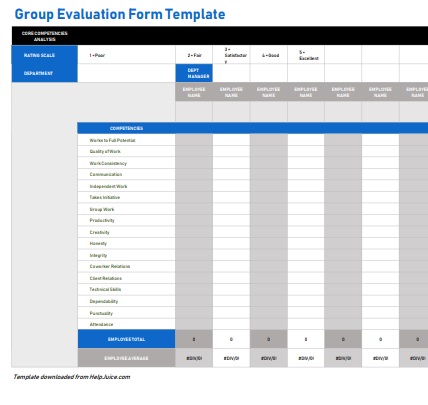
6. Employee Self-Evaluation Form
This self-assessment form is sometimes used in conjunction with an annual performance review template filled by the manager. The goal is to gain a better, unbiased overview of the employee’s abilities, actions, and quality of work.
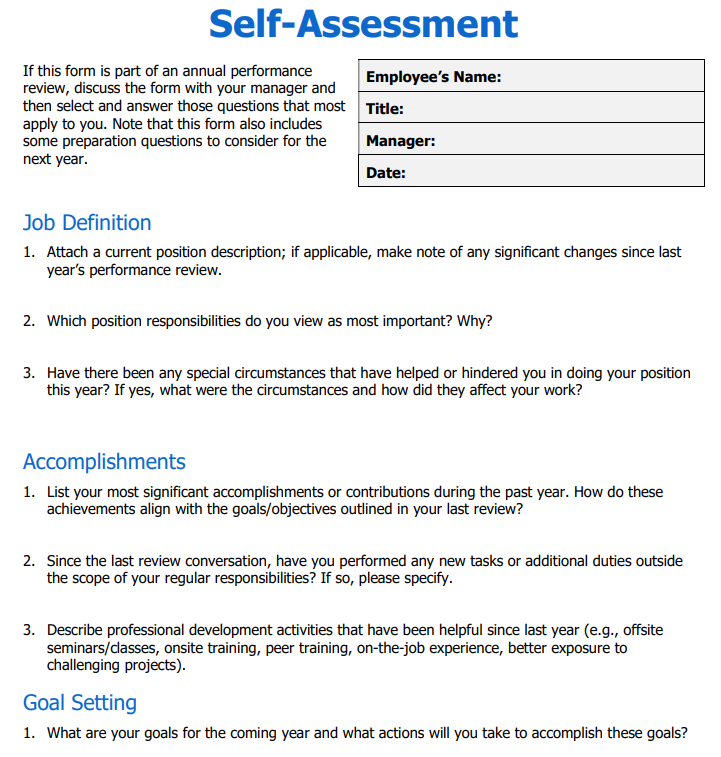
7. Introductory Period Performance Review Template
After employee onboarding is complete, this evaluation template can help determine if the new hire is a good fit for his or her current position as well as the company.
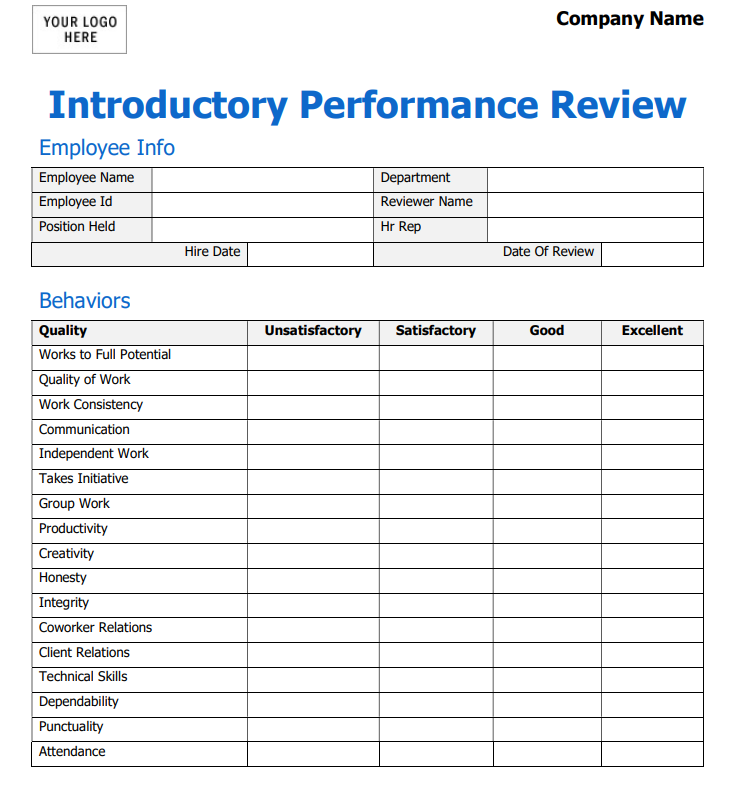
8. 30-60-90 Review Template
A 30-60-90 day template is an employee evaluation form that focuses on the employee's performance during the first 90 days of their employment. The purpose of a 30-60-90 day plan is to set clear expectations and goals for the new employee, provide them with a roadmap for success, and evaluate their progress during their first few months on the job. This evaluation form is commonly used for new hires or employees who are transitioning into a new role.
The template typically includes sections for the employee to set goals and objectives for their first 30, 60, and 90 days on the job. The employee outlines specific actions they plan to take during each phase, including tasks to complete, skills to learn, and relationships to build. The template also includes sections for the employee to reflect on their progress towards these goals and for the manager to provide feedback and guidance.
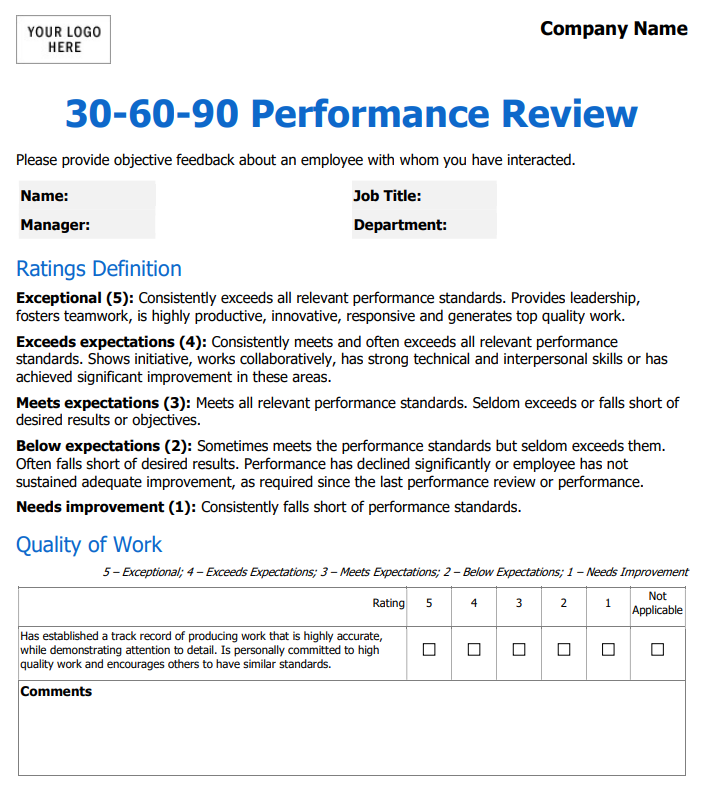
9. 360 Degree Feedback Form
A 360-degree feedback form is an employee evaluation form that gathers feedback from a variety of sources. This feedback may include input from the employee's supervisor, peers, direct reports, and even external stakeholders such as clients or customers. The goal of a 360-degree feedback form is to provide the employee with a more complete understanding of their strengths and weaknesses, as well as areas for improvement.
The 360-degree feedback form typically includes questions about the employee's job performance, communication skills, leadership abilities, and other relevant competencies. The questions may be open-ended or use a rating scale, and respondents are typically asked to provide specific examples to support their feedback. The feedback is collected anonymously to encourage honesty and candor.
The use of a 360-degree feedback form can be a valuable tool for organizations looking to improve employee performance and foster a culture of continuous improvement.
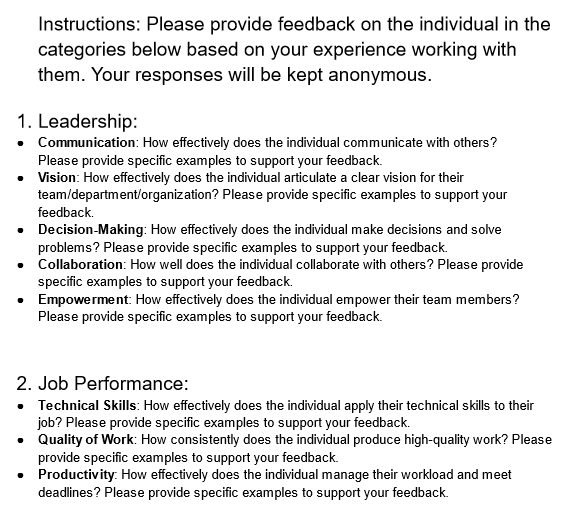
FAQs
When should an employee evaluation form be used?
Use these forms to document the results of annual or semi-annual performance reviews or at any other time when you need to rate an employee’s performance. You can utilize one form or a combination of several forms, e.g. General form + Self-assessment + Peer review.
Do employee performance evaluation forms make sense for small businesses?
Yes, small businesses also need to assess employee performance on a regular basis. If you use a predefined form or a set of forms, the process will be much easier and more predictable for you. You won’t have to come up with evaluation criteria every time.
How do you prepare employee performance reports?
It will be easier if you prepare well in advance. Here’s what you need:
- Be sure to keep an up-to-date file for each employee by documenting the feedback he or she received during the year
- Give the employee the ability to do a self-assessment
- Collaborate with HRs to improve discipline and incident reporting
- Before the appraisal, review the employee’s file
- After the appraisal, review all documents and evaluation forms to create a report
What should I write in an employee performance evaluation?
It depends on the position but, in most cases, you’ll want to cover quality and accuracy of work, communication and collaboration skills, problem-solving skills, adherence to deadlines, initiative, and reliability.
Conclusion
Even though employee evaluation may have a bad reputation, it’s still a must-have for organizations of all sizes. As Peter Drucker, famously said, “If you can’t measure it, you can’t improve it.” Employee evaluation forms, digital or on paper, are still the most widely used method to measure performance across all positions in your company.
To make sure your employee evaluation form is effective, focus on providing objective and honest rating. Include both numeric scales and open-ended questions to collect quantitative and qualitative data. Most importantly, make it a two-way conversation—engage employees in the evaluation and be the mentor who wants to help them improve.



.jpg)